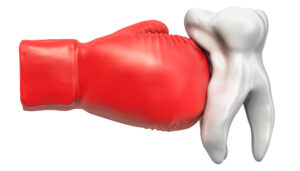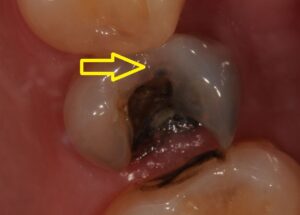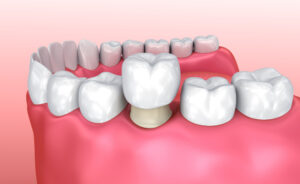Why Do Teeth Break?
Teeth are literally the hardest structures in the human body. And yet, they can break. Enamel and the underlying dentin are both harder than bone. How is it that people can break such hard substances, seemingly more easily than they break bones? We will explain the conditions that cause teeth to break in this week’s blog.
Injuries
 People often suffer from injuries or blows to the face that cause cracked or broken teeth. We commonly see these as the result of contact sports injuries or automobile accidents. People may suffer a broken tooth from a physical conflict.
People often suffer from injuries or blows to the face that cause cracked or broken teeth. We commonly see these as the result of contact sports injuries or automobile accidents. People may suffer a broken tooth from a physical conflict.
Whatever the cause, the result is that a strong, blunt force is powerful enough to break the integrity of enamel. Some breaks extend deeper into the tooth and affect the underlying dentin. Depending on the location of the fracture, it could also involve the nerve chamber within the tooth.
Many of these fractures are preventable by wearing a protective mouthguard during high-risk times (such as when you are playing hockey). Obviously, we know that no one plans to have a car accident or receive a punch in the face. To that, we can only say, drive safely and be kind.
Chewing Hard Substances
We can also break our teeth by chewing unusually hard substances. In a normal diet, this may involve hard nuts, like almonds, or snacks like Corn Nuts. Some people break teeth when there is a foreign substance in their food. Chewing carefully to avoid inadvertently biting down onto a surprise item is a good idea!
 People can also break teeth by chewing hard substances that are not food items. Some people have nervous habits of chewing on items like a pen or pencil. Others use their teeth as tools. These habits put more force on the teeth than the teeth can withstand. They are heavier forces than normal chewing requires. They add stress to the enamel, allowing cracks to develop and eventually penetrate into the tooth.
People can also break teeth by chewing hard substances that are not food items. Some people have nervous habits of chewing on items like a pen or pencil. Others use their teeth as tools. These habits put more force on the teeth than the teeth can withstand. They are heavier forces than normal chewing requires. They add stress to the enamel, allowing cracks to develop and eventually penetrate into the tooth.
This type of tooth breakage is also preventable by avoiding hard foods and bad habits!
Teeth Clenching/Grinding
Millions of Americans suffer from the subconscious sleep habit of bruxism. Bruxism includes both clenching and grinding of the teeth. This habit is not something you can control because you are asleep.
During sleep, bruxism causes a heavy clenching or side-to-side grinding movement of the teeth. The force of bruxism is also higher than the force of normal chewing, so it places teeth under a heavier burden than they can physically bear.
Over time, clenching and grinding damages the teeth through gradual wear and tear. Often this wear and tear includes small cracks that begin in the outermost layers of enamel and slowly progress into the internal structure of the teeth.
We can also prevent this type of damage to the teeth by wearing protective dental appliances during sleep. A mouthguard will separate the teeth, covering them and protecting them from the forces of bruxism.
Weakened by Decay
 Any teeth that are in a weakened state have a higher risk for breaking. Teeth are weakened by any loss of the integrity of the enamel layer. In a healthy tooth, enamel covers the entire exposed tooth (not including the roots) in a single, thick layer. The continuous nature of enamel underlies its strength.
Any teeth that are in a weakened state have a higher risk for breaking. Teeth are weakened by any loss of the integrity of the enamel layer. In a healthy tooth, enamel covers the entire exposed tooth (not including the roots) in a single, thick layer. The continuous nature of enamel underlies its strength.
Once something breaks or penetrates enamel, it is no longer a single continuous structure, and it is therefore very weak. One of the most common causes of this loss of integrity is through tooth decay (cavities). Cavities are bacterial infections of the hard structures of the teeth. Bacteria within dental plaque eat sugars and produce acid as a waste product. This acid dissolves enamel, allowing the bacteria to penetrate into the tooth.
Without treatment, a cavity will grow larger and larger into a tooth. As the bacteria work their way into the tooth, they leave behind soft, black decay where it was once healthy, hard enamel and dentin.
A decayed tooth is very likely to break under even light chewing forces. You can prevent this type of broken tooth by fighting cavities and seeing your dentist regularly. When you catch cavities in their early stages and treat them, the teeth will not break.
Weakened by Large Fillings
Similarly, even teeth restored from their state of decay are weaker than healthy natural teeth. When your dentist removes cavities and replaces the lost tooth structure with filling material, she restores the tooth back to its normal shape and function. One thing she cannot restore is its previous state of strength.
Fillings are a wonderful treatment for teeth with cavities, and they are necessary to stop the growth of the cavity into the tooth. However, they do not restore the enamel to its previously unbroken state. Teeth with large dental fillings have a higher risk for breaking than healthy, natural teeth.
In order to prevent large fillings, you must prevent the decay that caused the need for large fillings in the first place. Make sure you keep up great oral hygiene at home and see your dentist consistently.
How are Broken Teeth Fixed?
The treatment to repair broken teeth depends on the extent of the break. Some small enamel fractures only require a bonded tooth-colored filling. This is common on front teeth with chipped biting edges.
The larger the break, the more extensive the treatment. When a tooth breaks and the cracked portion extends deep within the tooth, we may not be able to save it with any dental treatment. This is because root fractures will never fully seal out bacteria or saliva. In these cases, the teeth require extraction to prevent infections in the future.

The most common treatment for a broken tooth is a dental crown. One simple way to envision a dental crown is as a replacement of the continuous enamel layer. Because a broken no longer has enamel integrity, we replace the enamel with a full coverage crown made from porcelain, metal, or a combination of the two. Your dentist uses dental cement to attach this replacement material over the prepared tooth, which restores the tooth back to its natural shape and function.
More Questions about Broken Teeth?
Call Designer Smiles today to schedule an evaluation with Dr. Ann today. She can assess your situation and help you proceed with the right treatment to fix your broken tooth.
